Gothic tattoos blend beauty and darkness in a way that’s hauntingly captivating. For women who are drawn to the mysterious, the romantic, and the rebellious, gothic tattoos offer a visual language that speaks to strength, elegance, and emotional depth. These designs often incorporate elements like skulls, ravens, black roses, medieval motifs, Victorian lace, and celestial symbols—all wrapped in an aesthetic that’s both bold and feminine.
Gothic tattoo ideas allow you to channel your individuality while embracing the allure of shadow and symbolism. Whether you’re into delicate blackwork, detailed line art, or deeply shaded realism, the gothic style lets you explore themes of life, death, passion, power, and mysticism in uniquely beautiful ways.
In this post, we’ll dive into how to choose the perfect gothic design, where to place it, how to care for it, and answer your most asked questions. Whether it’s your first tattoo or one more piece in your inked collection, gothic tattoos can turn your body into a canvas of dark beauty and mysterious charm.
How to Choose the Right Gothic Tattoo Idea for Women
Choosing the perfect gothic tattoo is both a creative and personal journey. These designs often carry rich symbolism and emotional weight, so it’s important to pick something that resonates deeply with your identity, beliefs, or personal story.
Start with a theme. Do you want something rooted in mythology? Do you connect with symbols of transformation, like ravens or moths? Are you drawn to gothic romance—like Victorian lace, cryptic roses, or broken mirrors? Or perhaps you’re inspired by medieval, witchy, or celestial elements? Starting with a theme will help narrow down your design options.
Style matters. Gothic tattoos can vary widely in style—from hyper-realistic black-and-gray to ornate ornamental linework or whimsical dark fantasy. Delicate yet dark designs (like finely inked skulls or dripping candle motifs) balance femininity with gothic flair. Bold blackwork, on the other hand, offers a strong, striking impact that can’t be ignored.
Don’t forget the meaning. While gothic tattoos are visually stunning, they’re also loaded with symbolism. A bat may symbolize rebirth or intuition. A moon may represent cycles or inner mystery. Even a rose dripping ink-black blood can tell a story of heartbreak or strength.
Work with an artist who understands gothic detail. Many gothic designs rely on subtle shading, intricate lace-like patterns, or dark surrealism that only experienced artists can pull off properly. A skilled tattoo artist will help refine your idea and place it where it flows with your body’s natural lines.
Choosing a gothic tattoo isn’t just about embracing the dark aesthetic—it’s about expressing a deeper part of yourself through ink and art.
Tattoo Placement Guide for Gothic Tattoo Ideas for Women
Gothic tattoos are just as much about where they go as what they depict. The placement can enhance the mystery, elegance, or intensity of your design, and it should reflect both your comfort level and personal style.
1. Upper Arm & Shoulder:
This is a versatile spot for showcasing gothic art like ravens, castles, or symbolic crosses. It’s large enough for detailed work and can be extended into a full sleeve if desired. It’s easy to conceal or show off, depending on your outfit.
2. Sternum & Ribcage:
One of the most intimate and sensual placements, perfect for ornamental lace, crescent moons, or sacred symbols. This area suits delicate gothic designs with intricate linework, and it adds a private power to the art.
3. Thigh:
Ideal for larger gothic pieces like full skeletons, gothic pin-up girls, or scene-based storytelling tattoos (like graveyards or tarot-inspired motifs). It offers a large, relatively flat surface and the ability to keep it hidden or flaunted.
4. Spine & Back:
The spine is a favorite for vertical gothic symbols—daggers, celestial arrangements, or script quotes in medieval fonts. Full back pieces also offer a stunning stage for dramatic, high-detail artwork like gothic angels or cemetery landscapes.
5. Forearm & Wrist:
Perfect for smaller yet impactful gothic pieces like gothic crosses, bat silhouettes, or dripping hearts. These areas are more visible, so choose designs you’re proud to showcase regularly.
6. Neck & Behind the Ear:
For women who embrace their edgy side, these placements are bold and eye-catching. Small gothic symbols—like a key, crescent moon, or flying moth—can look elegant and fierce in these hidden-but-daring locations.
Let your tattoo placement enhance the tone of your design. Whether mysterious, sensual, or bold, where you place your gothic tattoo can elevate the entire aesthetic.
10 Gothic Tattoo Ideas for Women
1. Gothic Cathedral Tattoo
A gothic cathedral tattoo captures the grandeur and mysticism of medieval architecture. With its towering spires, intricate stained-glass windows, and hauntingly beautiful details, this design symbolizes spirituality, history, and the gothic aesthetic. The tattoo can feature shadowy contrasts, adding a sense of mystery and depth. Ideal placements include the forearm, back, or thigh, where the intricate details can be appreciated. This tattoo is perfect for those who admire gothic architecture and want to showcase the beauty of ancient cathedrals as a tribute to their love for the dark and mysterious.
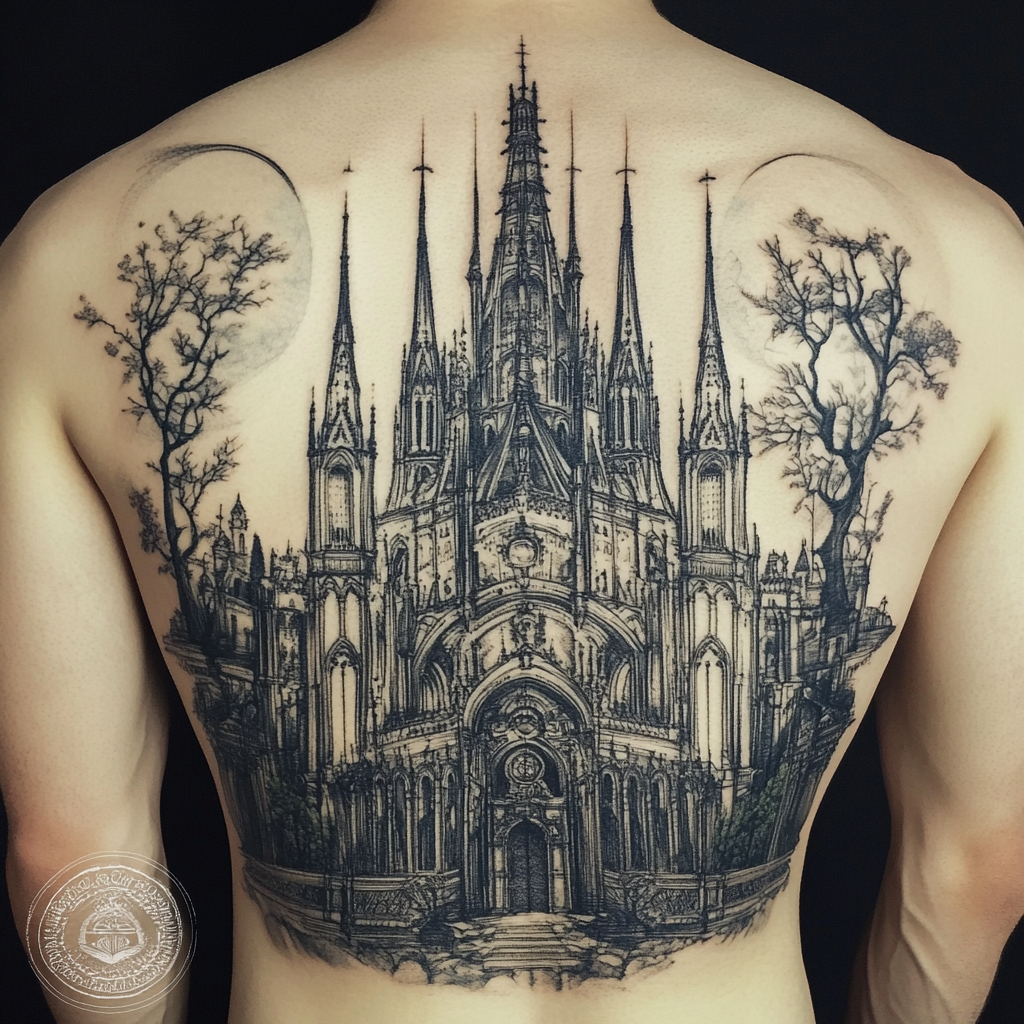
2. Raven Tattoo
The raven, often associated with death and prophecy, is a classic gothic symbol. Inspired by Edgar Allan Poe’s famous poem The Raven, this tattoo represents mystery, intelligence, and the supernatural. A raven can be depicted perching on a skull, flying through a storm, or with intricate Victorian embellishments. The rich black ink and fine detailing make it a striking design. Common placements include the shoulder, arm, or chest. This tattoo is ideal for those who resonate with gothic literature and the symbolic connection between ravens and the unknown.
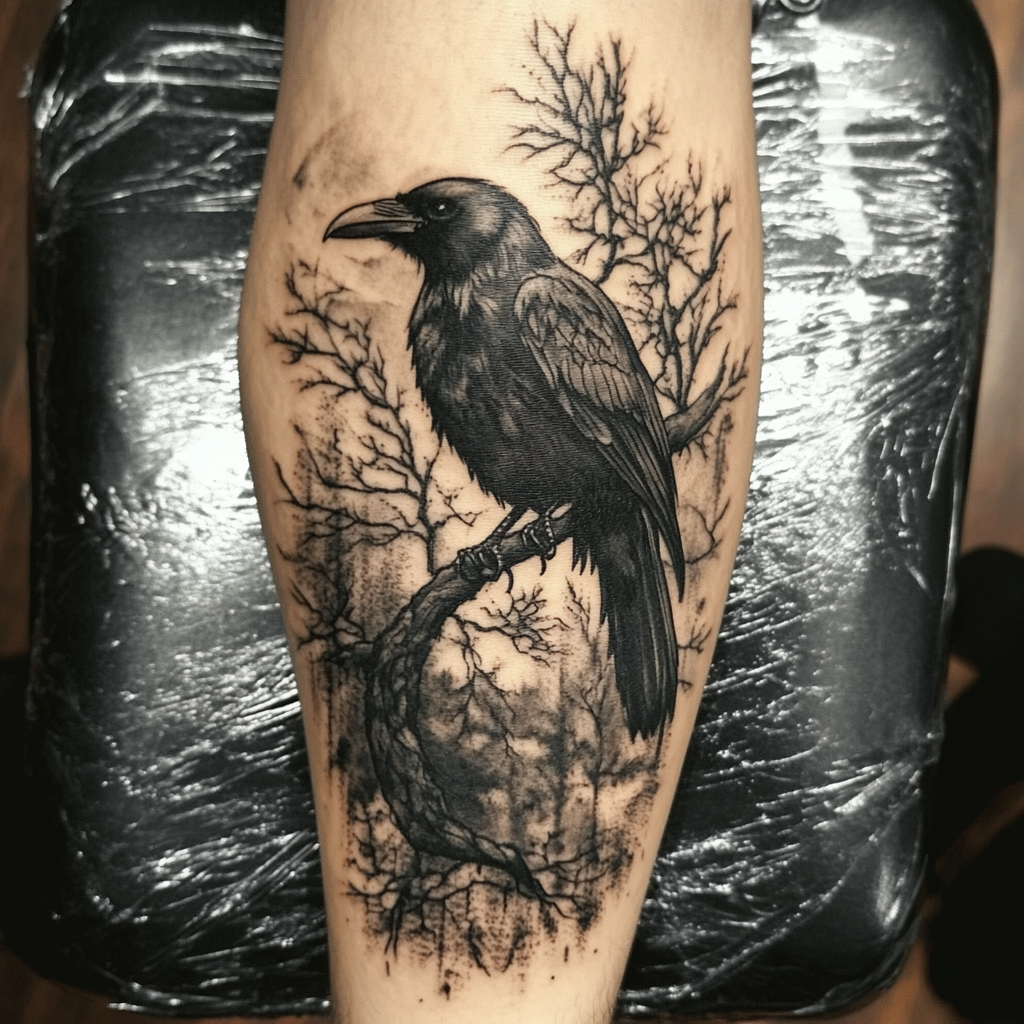
3. Skull and Roses Tattoo
A skull and roses tattoo blends themes of life and death, symbolizing the balance between beauty and mortality. The contrast of delicate roses entwined around a dark, detailed skull creates a haunting yet elegant design. The tattoo can be enhanced with gothic lettering, candles, or lace patterns for a Victorian touch. Popular placements include the thigh, forearm, or ribcage. This tattoo is perfect for those who embrace the gothic aesthetic and want a design that represents the fleeting nature of life while celebrating its beauty.
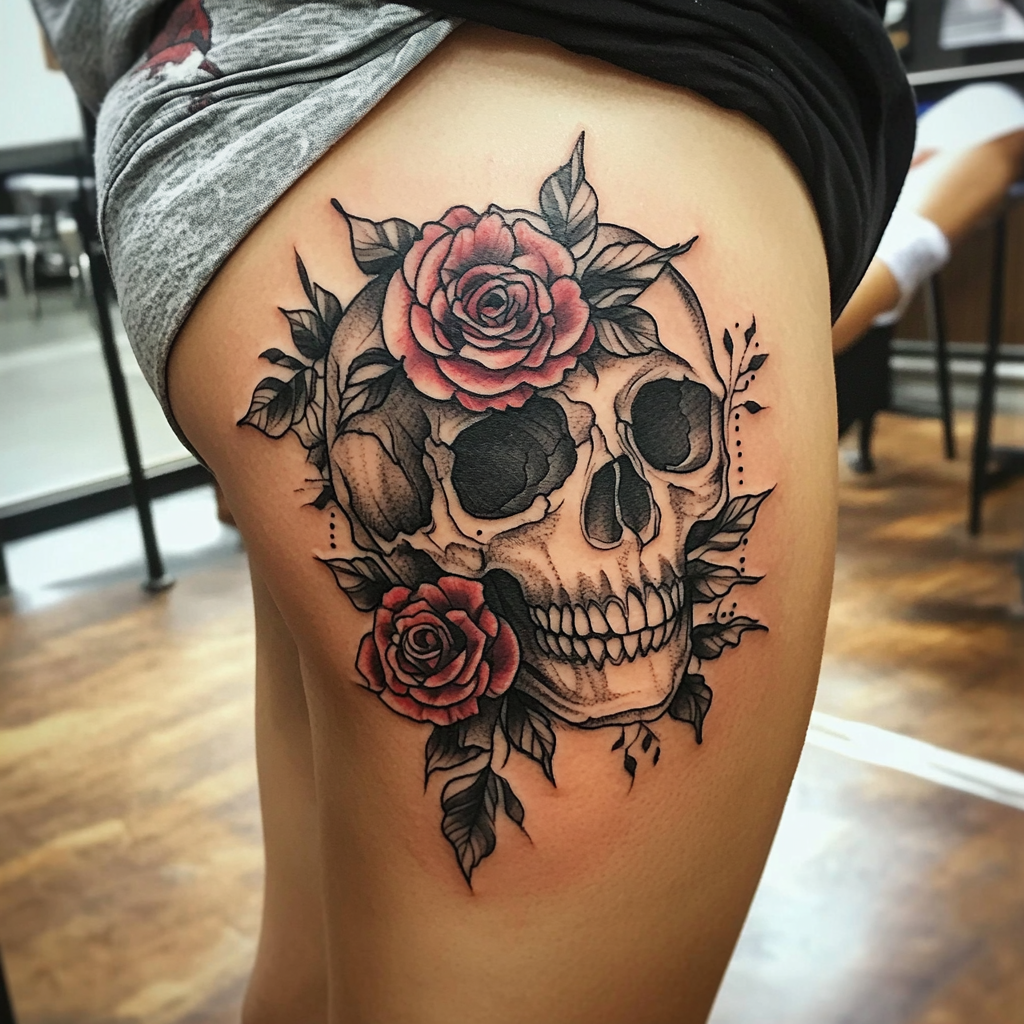
4. Gothic Cross Tattoo
A gothic cross tattoo is a powerful symbol of faith, darkness, and mystery. Featuring intricate baroque detailing, pointed edges, or black and red shading, this design exudes gothic elegance. Some variations include a cross adorned with roses, a crow perched on it, or chains wrapped around it for a dramatic effect. This tattoo is often placed on the upper arm, spine, or forearm, making it a prominent statement piece. It’s a great choice for those who admire gothic religious art and its fusion of beauty and solemnity.
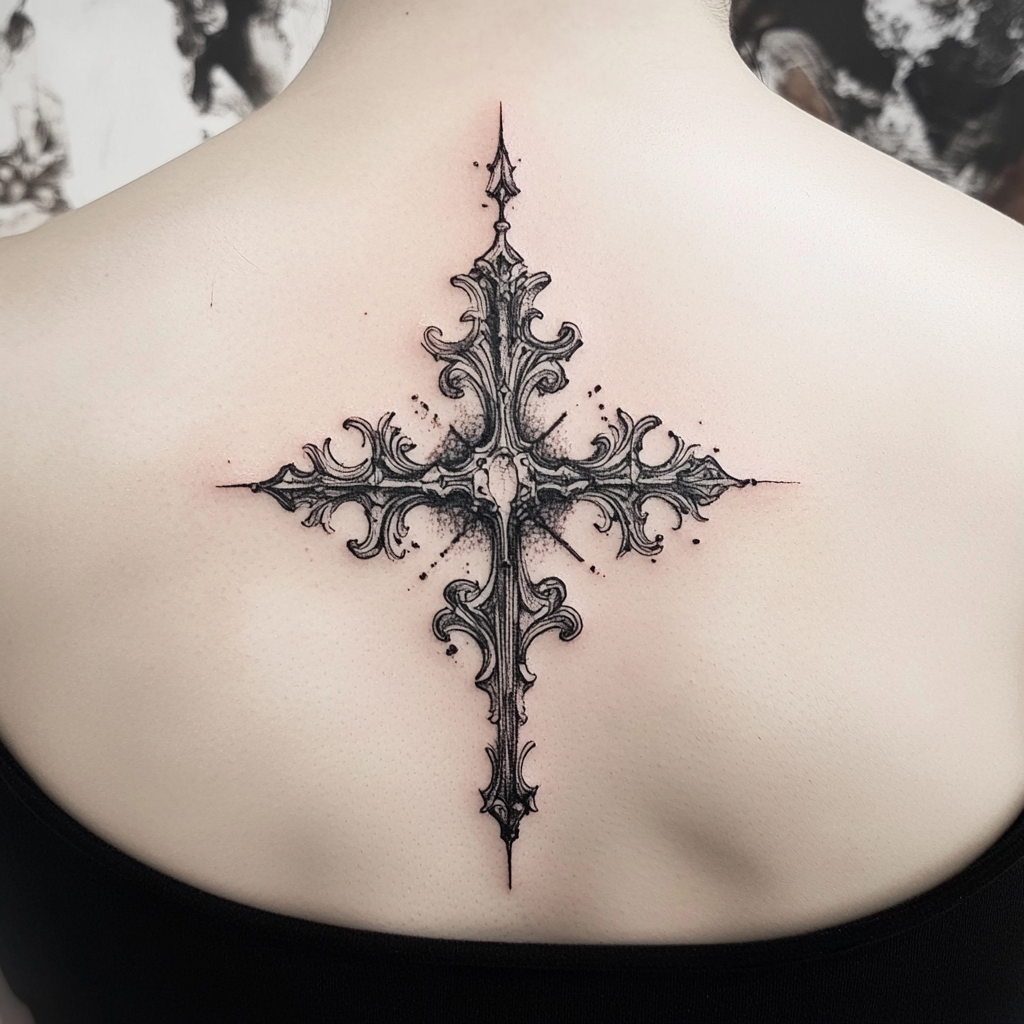
5. Gothic Script or Quote Tattoo
A gothic quote tattoo featuring script from gothic literature or Latin phrases adds a mysterious and intellectual touch. Phrases like Memento Mori (remember that you must die) or Carpe Noctem (seize the night) are popular choices. The font can be styled in ornate gothic lettering or elegant calligraphy. Placement options include the collarbone, ribs, or wrist for a subtle yet impactful design. This tattoo is perfect for those who appreciate gothic philosophy and literature, serving as a personal mantra of darkness, wisdom, and contemplation.
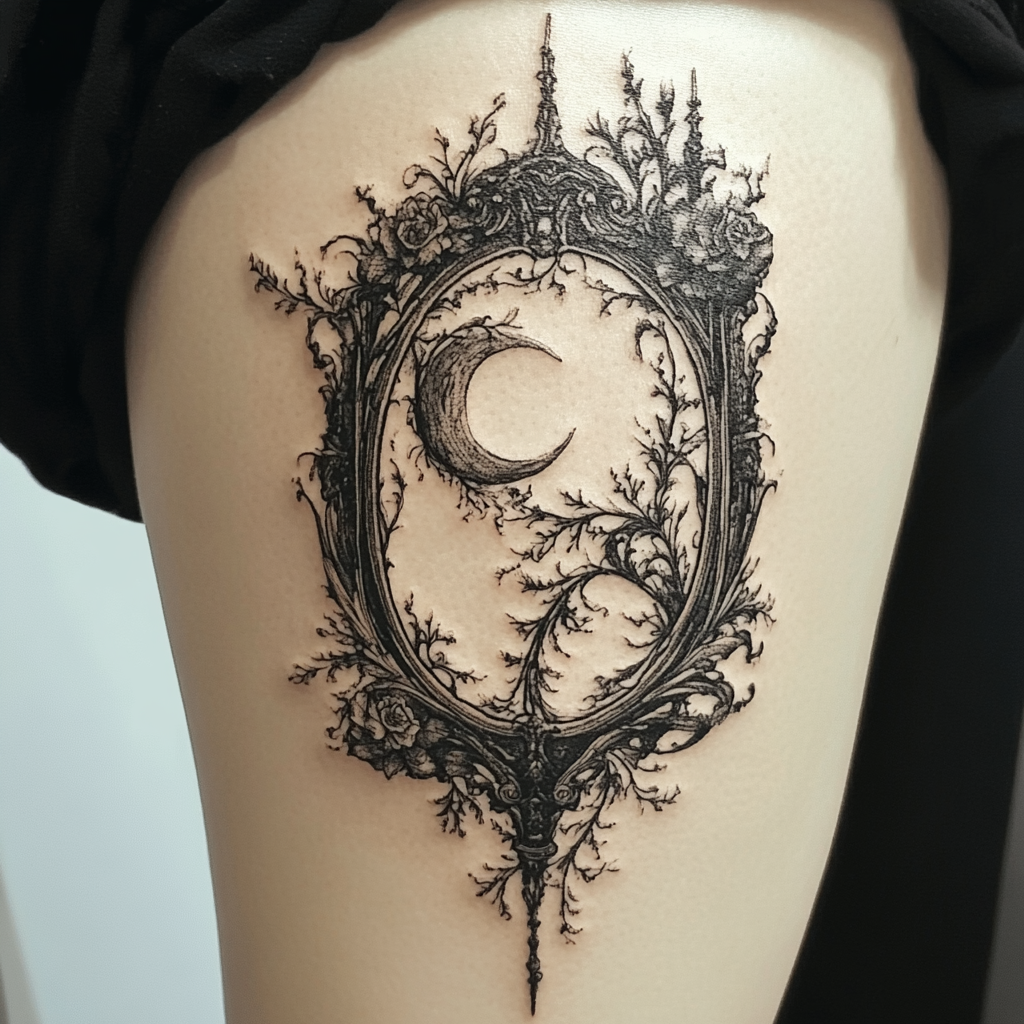
6. Black Lace Tattoo
Black lace tattoos mimic the delicate, intricate patterns of Victorian lace, exuding gothic romance and elegance. The lace can be designed as a bracelet around the wrist, a garter on the thigh, or a choker around the neck. Some variations include lace with roses, spiderwebs, or small skulls for added gothic charm. This tattoo style is ideal for those who appreciate the dark beauty of gothic fashion and want a design that is both feminine and mysterious.
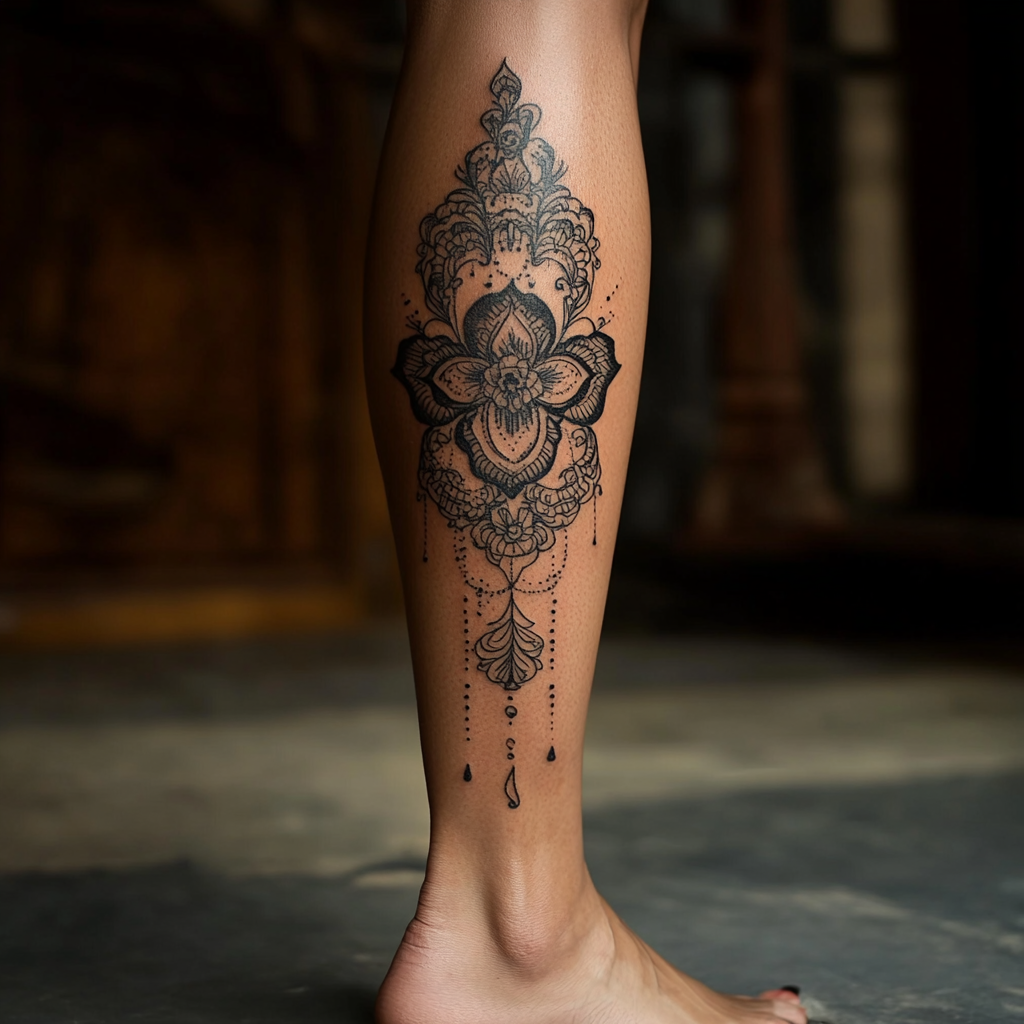
7. Bat Tattoo
Bats are iconic gothic creatures associated with night, mystery, and transformation. A bat tattoo can be designed with outstretched wings, forming a silhouette against the moon, or in a more stylized gothic art form. Some prefer a single bat, while others choose a swarm for added movement and depth. Placement options include the wrist, neck, or back. This tattoo is perfect for those drawn to nocturnal symbolism and the gothic connection between bats, darkness, and rebirth.
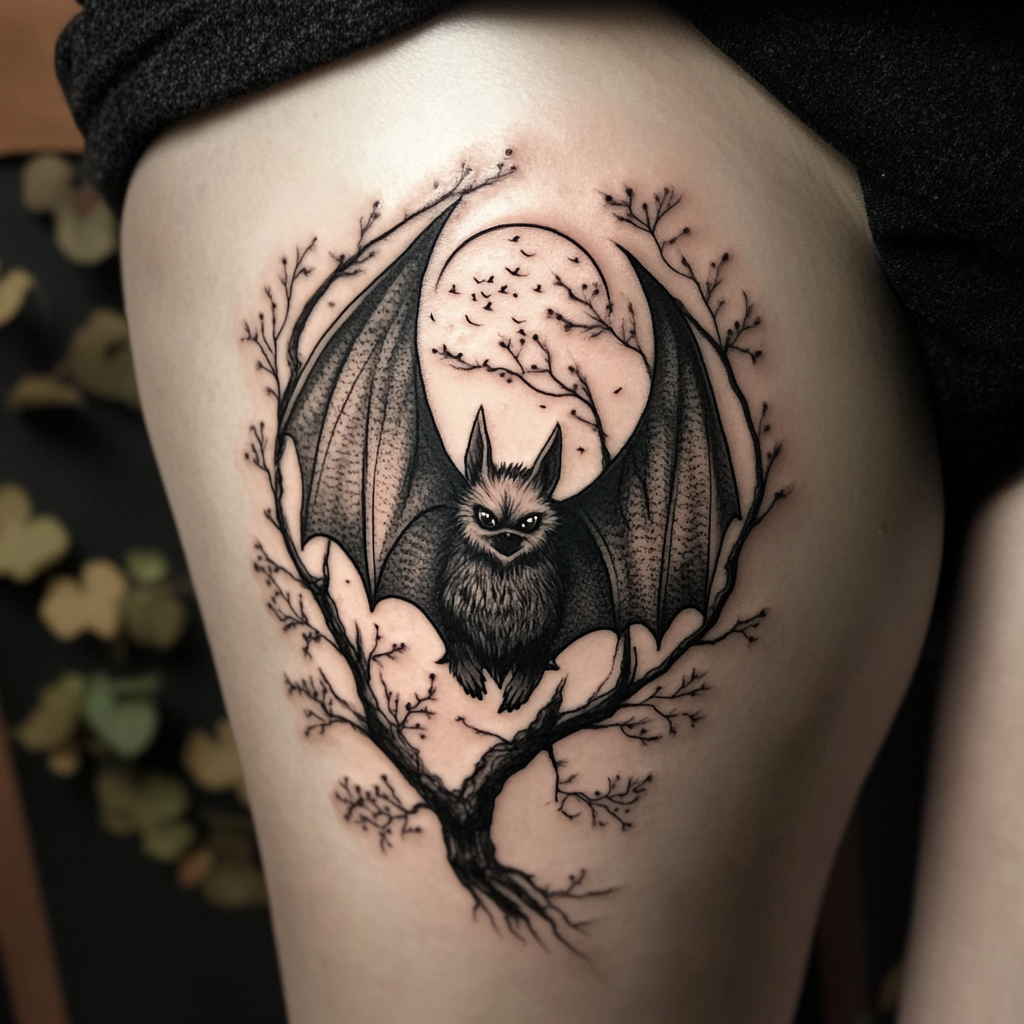
8. Coffin and Candles Tattoo
A coffin and candles tattoo represents themes of mortality and gothic mysticism. The coffin can be adorned with gothic engravings, while flickering candles add an eerie, haunting effect. Some designs include roses, crosses, or skeletal hands emerging from the shadows. This tattoo works well on the thigh, forearm, or back. It’s a bold choice for those who embrace the gothic fascination with death and the afterlife, symbolizing a deep appreciation for the mysteries of existence.
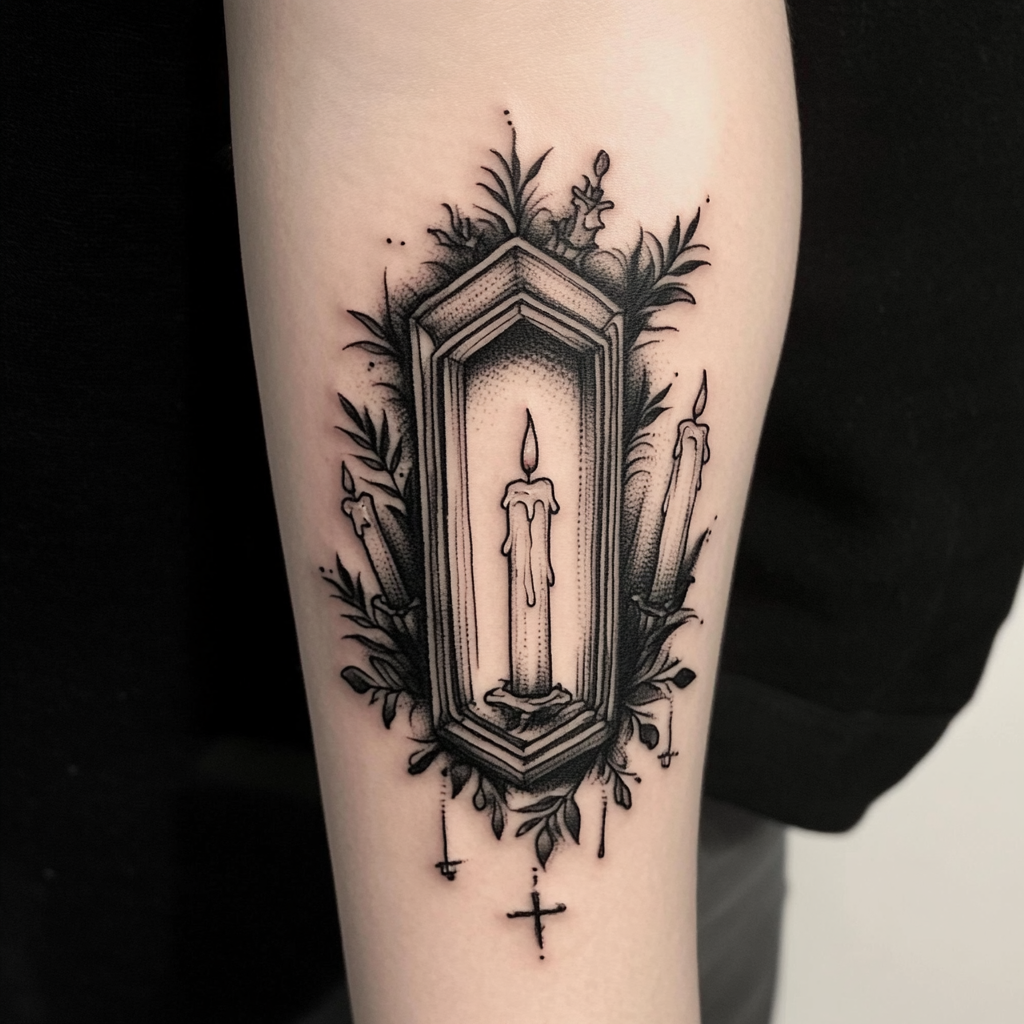
9. Gothic Moon and Stars Tattoo
A gothic moon and stars tattoo embodies the enchantment of the night sky. Often designed with swirling patterns, dark shading, and mystical symbols, this tattoo represents mystery, intuition, and the unknown. Some versions include a crescent moon with ravens or intricate filigree designs. The best placements for this tattoo are the shoulder, forearm, or back. It’s a great choice for those who feel connected to the night and gothic celestial themes.
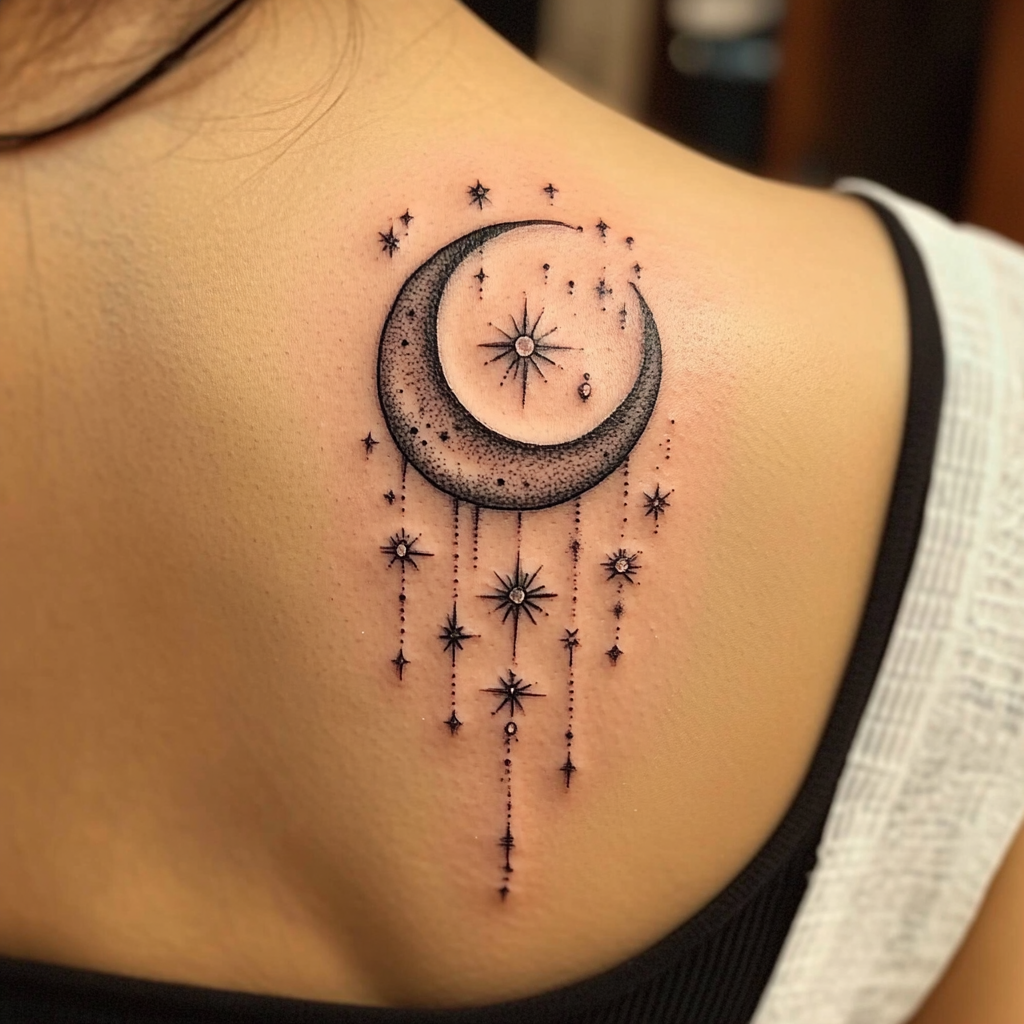
10. Gothic Dagger Tattoo
A gothic dagger tattoo symbolizes strength, mystery, and the darker side of human nature. The dagger can be entwined with roses, dripping with black ink “blood,” or embedded in a gothic heart. Some designs include ornate Victorian handles with intricate detailing. Ideal placements include the ribs, arm, or thigh. This tattoo is perfect for those who appreciate gothic symbolism and the idea of resilience, beauty, and danger coexisting in one striking design.
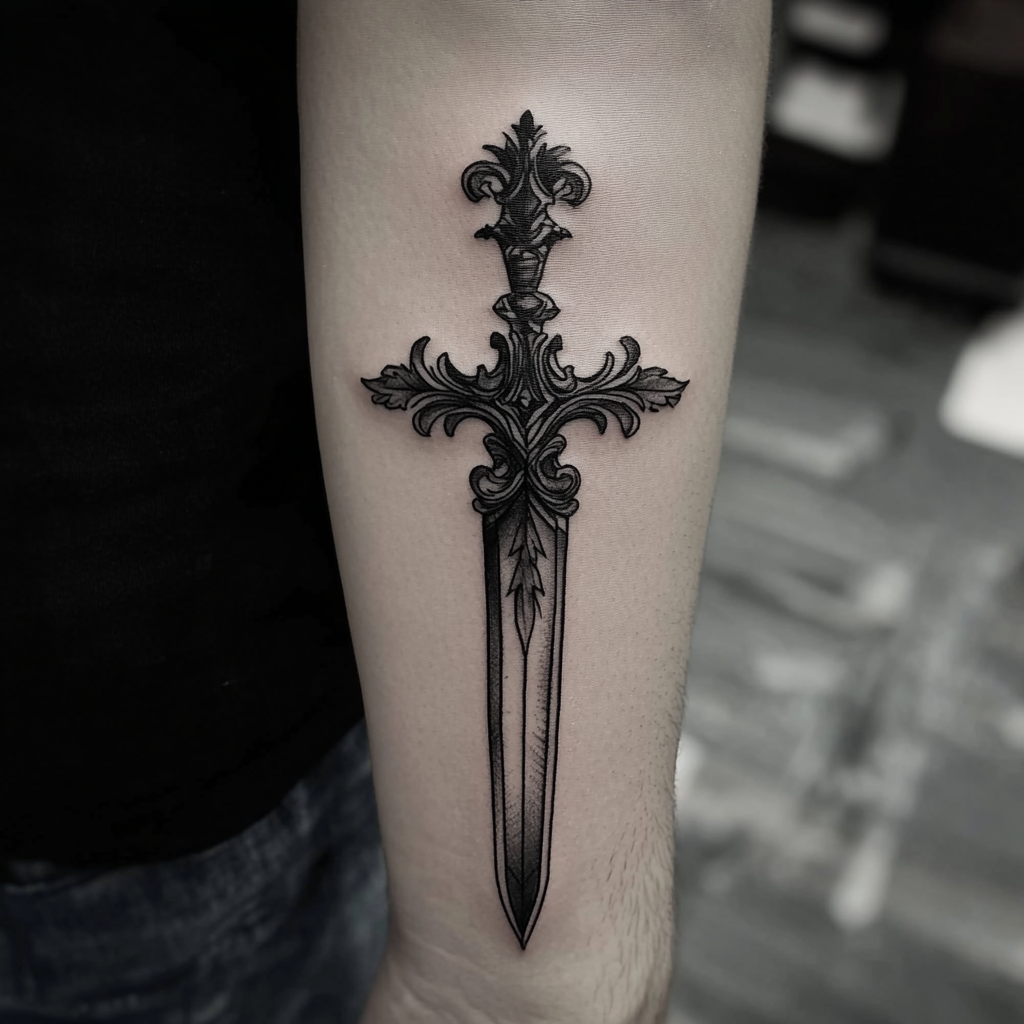
Tattoo Aftercare Tips for Gothic Ink
Once your gothic tattoo is complete, aftercare is essential to preserve the fine lines, dark shading, and elegant details that define the design. Here’s how to keep it looking crisp and hauntingly beautiful:
Listen to your artist first.
They know your skin and the tattoo style. Whether they recommend the wrap method, dry healing, or a specific balm, follow their routine closely in the first few days.
Keep it clean and gentle.
Wash the area 2–3 times a day with mild, unscented soap and lukewarm water. Avoid scrubbing. Gently pat the area dry and let it breathe before moisturizing.
Use light layers of tattoo-safe ointment.
Gothic tattoos often rely on delicate detail, so over-moisturizing can muddy the lines. Apply just enough lotion to keep the skin supple, not greasy.
Avoid direct sun and water exposure.
Sunlight fades ink fast, especially with black-heavy designs. Keep the tattoo covered or use SPF after it’s fully healed. No soaking in water—skip baths, swimming, and saunas during healing.
Hands off the healing process.
Let your tattoo peel and scab naturally. Picking or scratching can lead to patchy spots, blurred lines, or infection—none of which go with your gothic aesthetic.
With proper care, your gothic tattoo will remain a mesmerizing part of your story for years to come.
Final Thoughts
Gothic tattoo ideas for women go far beyond trends—they’re poetic expressions of beauty, mystery, strength, and soul. Whether it’s a shadowy rose, a haunted cathedral, or a constellation of stars inked in elegant blackwork, gothic tattoos tell stories that linger long after they’re seen.
These designs let you wear your darkness like armor and your femininity like a flame. They’re powerful, personal, and unapologetically you. So take your time, choose with intention, and work with an artist who can bring your vision to life with detail and depth.
In a world of fleeting fashion, a gothic tattoo is timeless. It doesn’t whisper—it lingers. And when worn with confidence, it becomes a piece of living art that is as haunting as it is beautiful.
FAQs
1. Are gothic tattoos only done in black ink?
While most gothic tattoos are known for their black or grayscale shading, you can absolutely incorporate color—especially deep reds, purples, and blues to add drama or highlight key elements. A blood-red rose, a glowing blue moon, or crimson eyes in a gothic portrait can elevate the impact. Still, black ink is a staple of gothic art because it emphasizes contrast, mystery, and shadow. Your artist can help you decide whether to go full monochrome or add touches of color for extra emotion and depth.
2. What symbols are commonly used in gothic tattoo designs for women?
Gothic tattoos pull from a wide range of powerful imagery. Popular symbols include ravens (wisdom, transformation), bats (intuition, rebirth), skulls (mortality), crescent moons (cycles, feminine energy), and black roses (romanticism with a dark twist). Gothic crosses, chandeliers, lace patterns, medieval keys, and Victorian-style frames also make frequent appearances. Each of these can be customized to reflect a personal story, memory, or spiritual connection, allowing your tattoo to go beyond visuals and into something truly meaningful.
3. Can gothic tattoos still feel feminine and elegant?
Absolutely. Gothic doesn’t mean harsh or masculine—it means dramatic, emotional, and expressive. Women’s gothic tattoos often strike a balance between softness and strength. Think lace overlays, delicate shading, or flowing floral designs paired with darker motifs like skulls or moons. Even intricate script in an old English font or a symmetrical mandala with gothic flair can look both fierce and feminine. The style you choose and how it fits your body shape will influence how the final tattoo reads.
4. Do gothic tattoos require more touch-ups than other styles?
Not necessarily. Like any tattoo, how well your gothic piece holds up depends on placement, ink quality, aftercare, and sun protection. Since gothic tattoos often rely on deep black ink and detailed shading, they can actually last longer than fine-line or color-heavy styles—especially when placed on areas that don’t stretch or rub too much. However, touch-ups might be needed for highly detailed or intricate designs over time, especially if the piece involves a lot of delicate linework or soft gradients.